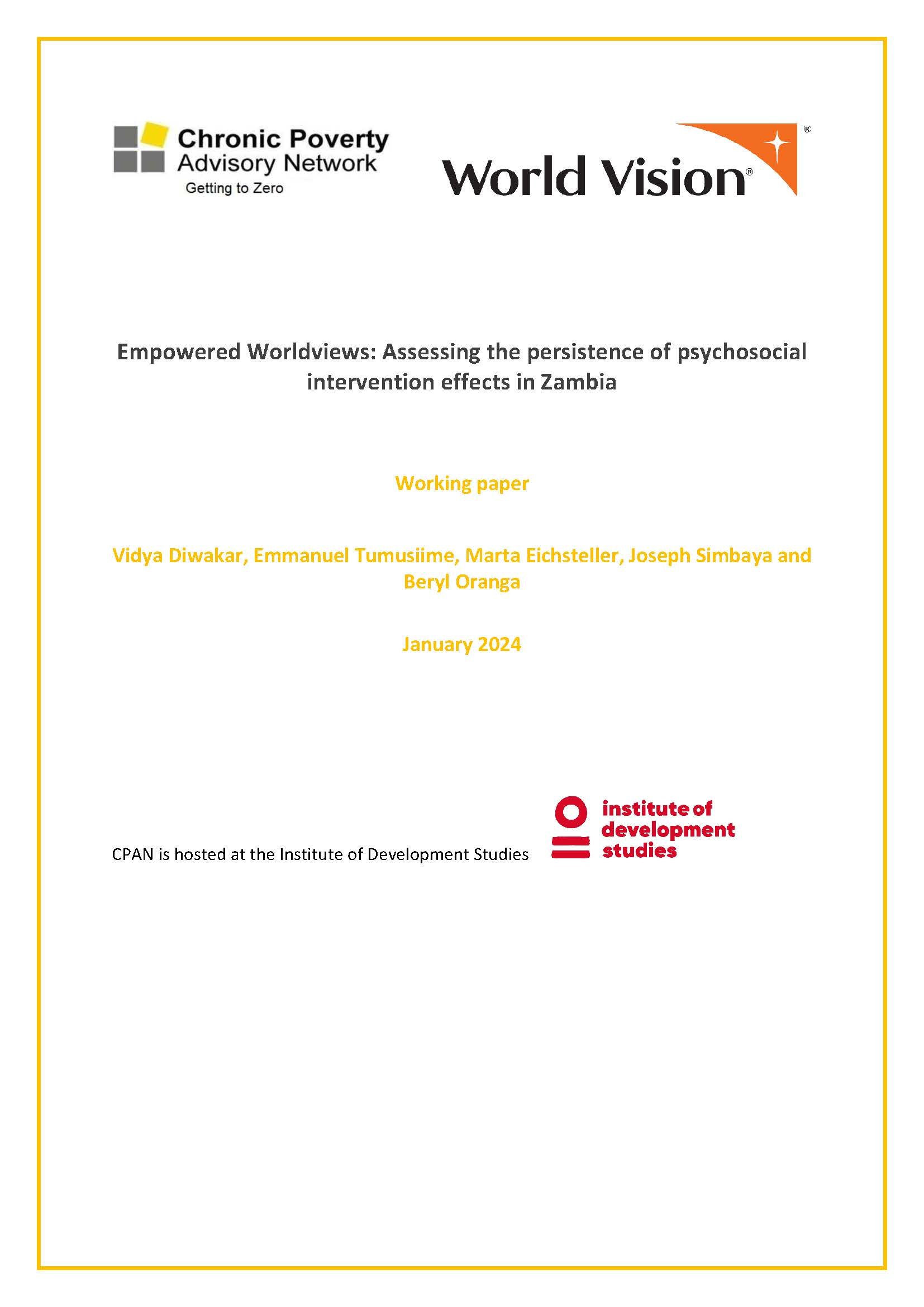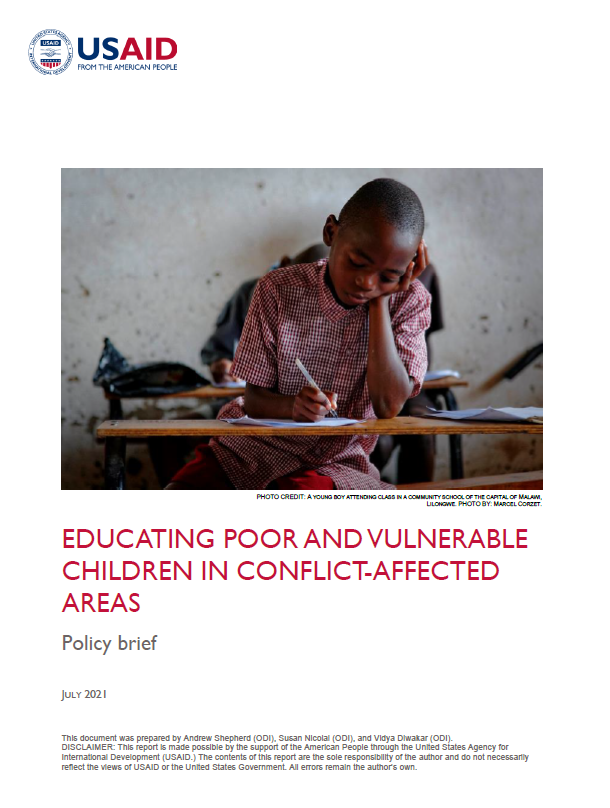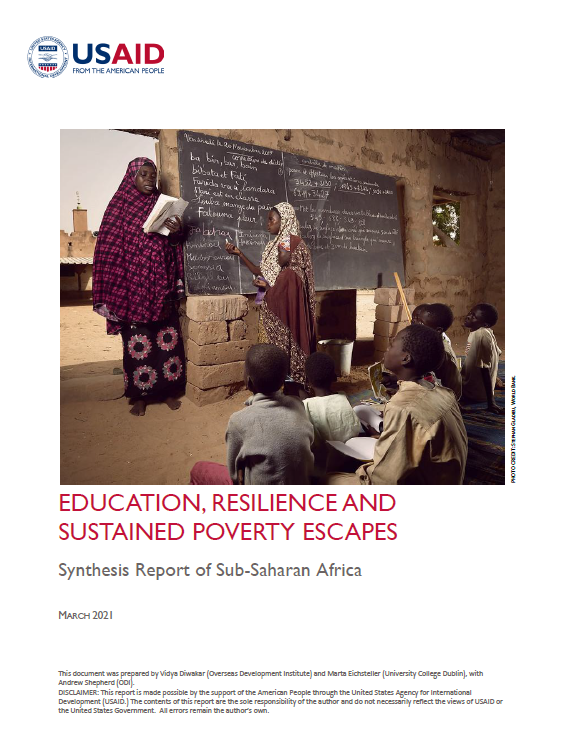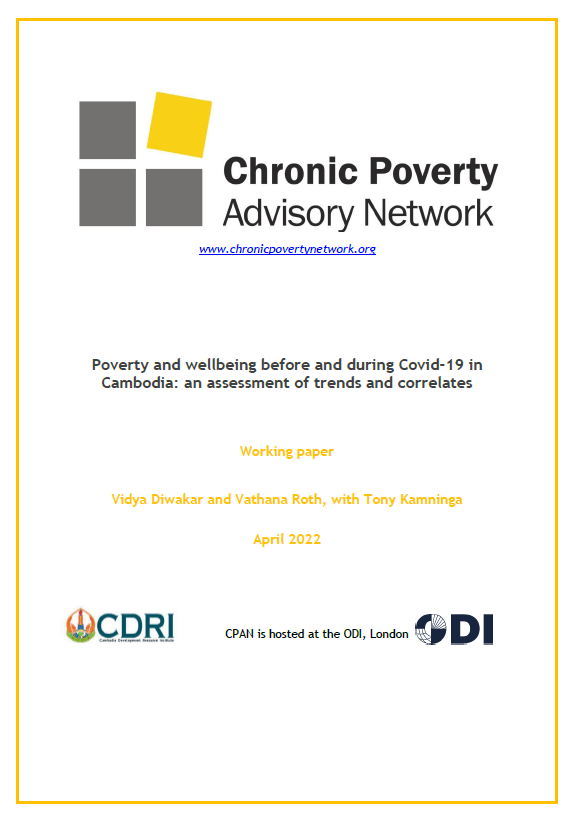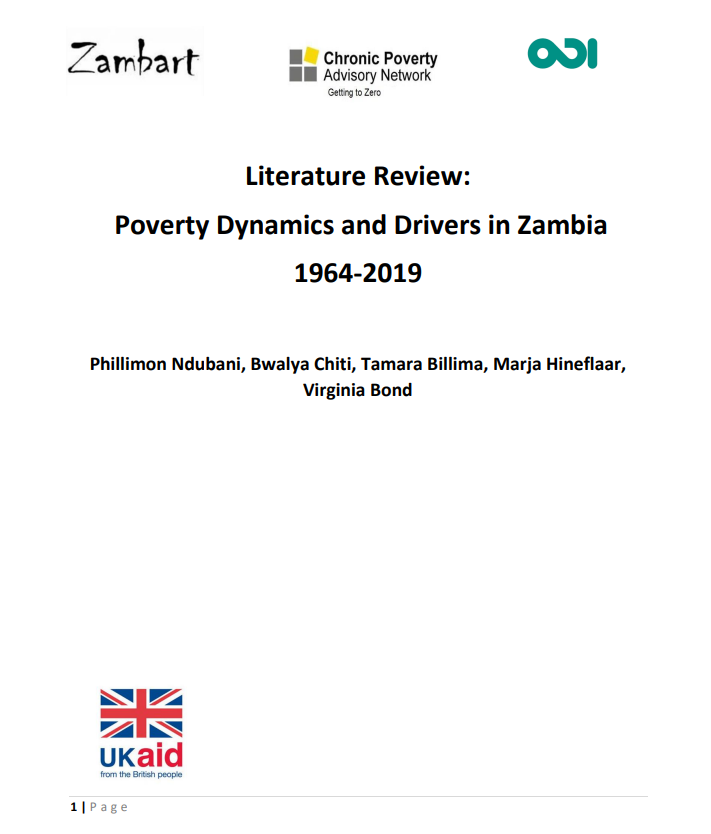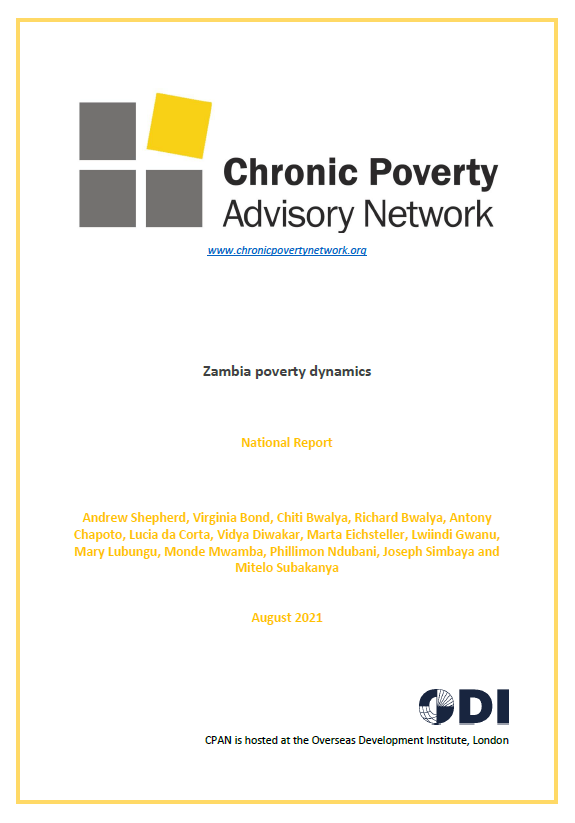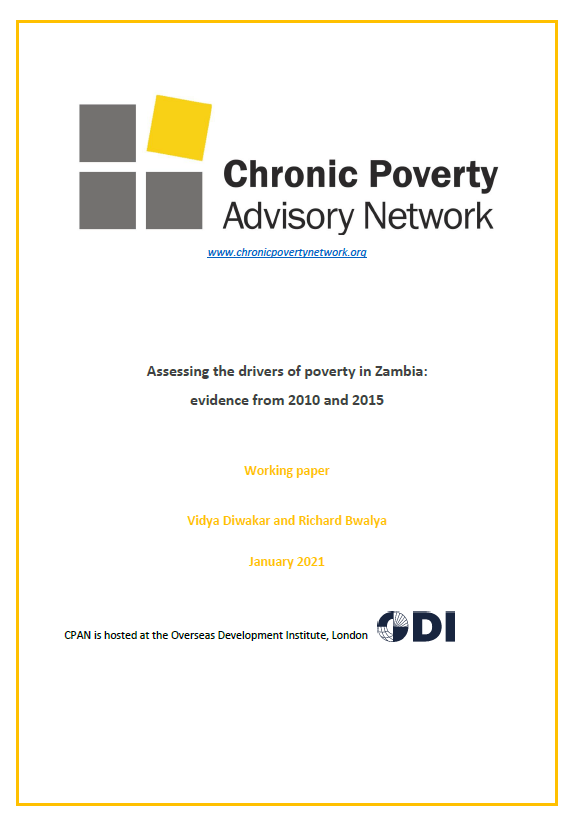This paper investigates the role of crises (e.g. armed conflict, displacement, climate-related disasters, Covid‑19, and economic crises) in driving negative poverty trajectories in Nigeria, alongside the extent to which social assistance may be fit for purpose to respond to intersecting crises. The paper adopts a mixed-methods approach, bringing together analysis of quantitative survey data from 2010 to 2023, with qualitative data collected in six states across the country’s six geopolitical zones in 2023. Study findings point to intersecting crises driving both the acuteness of chronic poverty as well as new instances of impoverishment that are becoming sustained. Social assistance – albeit constrained by limited coverage – plays an important role by supporting promotive and protective means of coping during crises. Based on the study findings, policy recommendations include expanding social assistance coverage, strengthening conflict resolution and peace-building, promoting equity-centred economic policy responses, and addressing underlying structural challenges.
UN DESA Policy Brief No. 160: The Dynamics of Poverty - Creating Resilience to Sustain Progress
The World Social Report 2025 (forthcoming) will offer a survey of social challenges that stand in the way of progress towards the Sustainable Development Goals. A series of thematic papers is being developed by UNDESA to provide more detailed analysis on each of these challenges, including the core commitments from the 1995 Copenhagen Declaration and Programme of Action. The first of the thematic papers focuses on poverty, and draws on a background paper produced by Andrew Shepherd and Vidya Diwakar. Linked to the thematic paper and its associated policy brief are presented here.
The thematic paper recognizes that world has made significant headway towards eradicating poverty in recent decades. Accelerating the speed of progress and avoiding setbacks remain critical challenges. While poverty is increasingly entrenched in the poorest countries and regions, the Covid-19 pandemic and subsequent crises have exposed that gains are fragile, even in countries that had succeeded in reducing it. Growing evidence on the dynamics of poverty shows that many people are still one misfortune away from falling below the poverty line. Many do so, despite declines in the total number of people in poverty. Progress in reducing it is much more volatile than the conventional, aggregate picture of gradual reductions suggests. Covid-19 and the growing threats from climate change and conflict serve as yet another reminder that reaching the elusive goal of eradicating poverty is not only a matter of lifting people above it. It also requires creating resilience.
Empowered Worldviews: Assessing the persistence of psychosocial intervention effects in Zambia
Evidence on the persistence of psychosocial outcomes of interventions over the medium and long term, and in the face of shocks and stressors, is limited. We examined the extent to which empowerment associated with a psychosocial, faith-based approach, Empowered Worldview (EWV) persisted 3–5 years post-delivery of the intervention in Zambia among smallholder farmers. The EWV intervention in Zambia was delivered as part of THRIVE, an integrated livelihoods programme. We followed a previous study to disaggregate individual-level empowerment associated with EWV into three domains: internal (which relates to ‘power within’), localised (typically participation and access), and structural (e.g. institutional, environmental, and social structures).
To explore the persistence of EWV effects on empowerment, we used mixed methods and longitudinal data collected in 2020 and 2023, which were the midline and endline points of the THRIVE programme. Empirically, we used descriptive and regression analysis to compare internal and localised empowerment levels between the survey rounds (2020 and 2023) across study groups – including groups that received EWV before and after 2020 – and to the control group. We also re-interviewed a subset of EWV participants interviewed in 2020 to understand how empowerment has changed at the individual level over time.
Life history diagram for Beatrice.
The results show levels of internal empowerment associated with the EWV intervention persisted between the midline and endline surveys, especially when combined with THRIVE livelihood interventions. At the midline, 80.0 per cent of THRIVE with EWV participants were empowered, compared to 82.3 per cent at the endline. In contrast, 72.6 per cent and 73.07 per cent of the control sample participants were empowered at the midline and the endline, respectively. Quantitative results further show that localised empowerment significantly improved between survey rounds among participants who received EWV training and is positively associated with internal empowerment, consistent with literature that suggests localised enablers (supporting social environments) are crucial to sustaining internal empowerment. The qualitative data shows that persistent internal and localised empowerment was observed mostly among households in the non-poor wellbeing category, suggesting that additional interventions are needed to reach the poorest participants. Results also show internal and localised empowerment are positively associated with indicators of household resilience. We conclude the paper with recommendations for programming.
Life history diagram for Edward
Click here to read the full report
For further insights on the first phase of the study, click here
Zambia Poverty Dynamics Research
The policy agenda proposed here builds on good measures already taken by the Government of Zambia in education, social protection, debt relief and macroeconomic management, and addresses the challenges that remain in creating a more prosperous and equal Zambia.
The rate of poverty reduction slowed in Zambia during the 2010s, and especially with the 2019 drought and policy responses to the pandemic. A high level of rural chronic poverty is associated with farming and other natural resource-based occupations, suggesting that natural resource management requires significant policy attention. Surprisingly, chronic poverty is highest in eastern and southern Zambia, despite the maize- and livestock-based economics in those regions.
In the context of continuing climate change, risks to natural resource-based occupations are increasing rapidly, which keeps people poor. Sustained escapes from poverty have not exceeded downward mobility into poverty. Urbanised provinces have typically done better than rural ones in reducing extreme poverty and deprivation.
Zambia’s debt servicing obligations and low economic growth have meant that public expenditure is constrained, though a little less in 2023 than in 2022 when reduced debt servicing allowed increased allocations to education and social protection budgets among others. Significantly greater public expenditure will be needed to recapture a higher rate of poverty reduction. However, it is also important that expenditure goes to items that will reach and benefit poor and vulnerable people.
This policy brief recommends a series measures, several of which are already underway, and within a sound macroeconomic management framework that has been put in place.
Educating poor and vulnerable children in conflict-affected areas: Policy Brief
Education is recognized to be a ‘portable asset’ (Bird et al. 2010)—one with intrinsic as well as instrumental value and with the potential to contribute to sustained escapes from poverty (Diwakar et al. 2021). However, education access might be compromised in areas affected by armed conflict due to various supply- and demand-side factors. These range from limited state budgets, destruction of infrastructure, displacement of students and teachers, constrained household expenditures, and a general context of insecurity that may limit decisions to enroll. In this way, conflict “damages education from above [through national budgets] and below [through household budgets]” (UNESCO 2011).
Accordingly, a context-specific selection of demand-supporting as well as supply-enhancing measures for promoting formal education is needed in conflict-affected areas (CAAs). Supporting demand for education is critical in CAAs, as conflict can so easily reinforce other constraints on demand. Key demand-boosting measures more generally include: early childhood care and education; school feeding; enhancing quality throughout the system (especially in the early years of primary school); special attention to ensure the continued education of girls; and support for vulnerable children in their transitions between education levels and into the labor market, self-employment or further training. Though not specific to CAAs, a focus on these measures could help ease the financial constraints of households in CAAs, so that the motivation to support children through education remains strong for parents and wider social networks.
There are also supply-side fundamentals which need to be assured in CAAs: above all, that schools need to be safe and secure. Other supply-side needs in CAAs include: improving infrastructure and resources (including teaching materials and updated curricula) to maintain education systems amid widespread insecurity and the destruction (UNESCO 2011); teacher training for work in CAAs; and addressing distributional effects stemming from factors such as restrictions in population movements or the co-option of education by conflict parties (Justino 2016). This is often a big issue in CAA where schools, especially at secondary level, can be arenas of conflict for warring parties.
This brief recommends education policy and programming priorities stemming from recent research on education, conflict, and resilience in sub-Saharan Africa (see Box 1). Based on the research findings, it draws attention to how to meet challenges related to opportunity costs (by investigating how to support poor and vulnerable children into secondary education, and how to improve quality), and how to help link education with labor markets to strengthen households’ financial resilience in CAAs.
Authors: Andrew Shepherd (ODI), Susan Nicolai (ODI), and Vidya Diwakar (ODI).
Education, resilience and sustained poverty escapes: Synthesis Report of Sub Saharan Africa
Resilience is defined as the “ability of people, households, communities, countries, and systems to mitigate, adapt to, and recover from shocks and stresses in a manner that reduces chronic vulnerability and facilitates inclusive growth” (USAID 2012, 5). While there have been important gains in poverty reduction internationally over the last two decades, there is a concurrent recognition that without nurturing resilience, these gains are fragile and may risk reversal in a multi-hazard context. Developing resilience is arguably a central component of ensuring sustained poverty reduction. A key way in which resilience can be strengthened is through education. In turn, resilience capacities can improve education outcomes. Combined together, sets of resilience capacities have the potential to contribute to sustained poverty reduction.
This paper analyzes this interrelationship between resilience, education, and sustained poverty reduction in sub-Saharan Africa. It synthesizes mixed-methods research by the Chronic Poverty Advisory Network (CPAN) to contribute to this knowledge base by focusing on data from Tanzania, Rwanda, Niger, Malawi, Ethiopia, Uganda, and rural Kenya, drawing out regional conclusions where possible, while also exploring country-level and intra-country differences. This study adopts a resilience framing to examine the potential for sustained development gains through poverty reduction, within a multi-hazard context. It focuses on the role of education as a resilience capacity, and other capacities improving education outcomes—both of which operate primarily at the adaptive and absorptive level (see Figure 1 and Table 1). It recognizes instances when education as a resilience capacity combines with certain resilience capacities improving education outcomes, which can have a transformative potential to drive escapes from poverty that are sustained over time.
Authors: Vidya Diwakar (Overseas Development Institute) and Marta Eichsteller (University College Dublin), with Andrew Shepherd (ODI).
Education, resilience and sustained poverty escapes: Policy Brief
Education is widely recognized as providing pathways out of poverty and a key resource with which to interrupt the inter-generational persistence of poverty. However, access, progression and quality constraints combined with household disadvantages and sluggish labor markets mean that the potential is not always achieved. This brief summarizes what can be done to promote a stronger role for education in poverty reduction, based on research which synthesizes findings on education and poverty dynamics across a number of developing countries (see summary in Box 1). The brief is intended for decision-makers and practitioners in education together with others focused on broader aspects of poverty reduction.
USAID’s approach to education and poverty reduction has been to support ‘learning out of poverty’ and especially the basic education which will help achieve equitable access and sustained improved learning outcomes (USAID Education Policy 2018). Better learning outcomes for poor children lead to higher future child survival rates, lifelong higher productivity and incomes, protection against ill health, and, in the case of educated women, a higher rate of investment in family by comparison with that of men. Building human capital contributes to achieving the inclusive and sustainable economic growth which in turn reduces extreme poverty. This brief not only reflects on education policy and programming priorities emerging from research on poverty dynamics and education, but also on how to promote the kind of household resilience capacities which are necessary to support poor children to progress far enough through the education system to make a difference to their and their families’ futures. There has been less consideration of this latter topic in existing USAID policy documents.
Author: Andrew Shepherd
The brief can be downloaded here
The associated report can be downloaded here
Poverty and wellbeing before and during Covid-19 in Cambodia: an assessment of trends and correlates
This study investigates factors affecting welfare prior to and during Covid-19. It employs analysis of the Cambodia Living Standards Measurement—Plus Survey 2019/20 data, alongside five rounds of the Covid-19 High Frequency Phone Surveys between May 2020 and March 2021 to assess socioeconomic impacts of the pandemic.
The results point to a range of factors which could contribute to explaining poverty incidence prior to the pandemic. Household resource endowment was an important correlate of welfare, particularly in terms of possession of a mobile phone, ownership of livestock and land and access to electricity. Other factors include access to financial services, education, involvement in non-agriculture businesses, migration and remittances. However, a range of these variables are being constrained during Covid-19. For example, analysis of Covid-19 phone surveys points to the severity of income loss both in terms of breadth (share of households affected) and depth, the latter more pronounced in proportional terms among households in the bottom two quintiles with an already low consumption base, and also severe among IDPoor households. In other words, not only has income loss been deep, but it continues to get deeper over time, starting from a low base. This suggests that there are considerable processes of impoverishment (breadth), but also destitution (depth) in Cambodia as a result of Covid-19.
As a result of shocks, households were forced to rely on a range of coping strategies, especially reducing consumption, taking loans and, for poorer households in later survey waves, accessing social protection. Reliance on support from friends has been reducing over time, perhaps a result of community networks thinning out. Even though the roll-out of cash transfers has eventually reached many ID Poor households, levels may not be adequate resulting in reductions in food consumption among poorer households and continued food insecurity.
The results point to areas for policy and programming focus, including helping to narrow development gaps by area of residence alongside a regional levelling up focused on the Tonle Sap region. Alternatives to borrowing as a coping strategy are also worth considering, alongside improvements in inclusive access and quality of financial services to help mitigate the adverse consequences of indebtedness. Alongside this is a need to focus attention on children who have missed out on school and learning, particularly from poorer households.
Authors: Vidya Diwakar and Vathana Roth, with Tony Kamninga
Literature Review: Poverty Dynamics and Drivers in Zambia (1964-2019)
The Zambian Chronic poverty study, for which this literature review has been conducted, investigates and interrogates chronic poverty dynamics in Zambia. Although chronic poverty has existed for a long time, no specific study of this magnitude and scope has been conducted to provide a comprehensive understanding of chronic poverty dynamics in the country. The study has two objectives as follows:
The study seeks to establish a dynamic understanding of the chronically poor in the post-2010 period in Zambia, to draw conclusions about who is being left behind, why and what can be done about it.
The second objective is to establish a qualitative baseline for future monitoring work, similar to the WIDE project in Ethiopia.
The key research questions include:
Why has extreme poverty (and hunger) remained at such a high level and so widespread especially in rural areas, despite economic growth, political stability, and a reasonable human development record?
To what extent is this accounted for by chronic poverty or by mobility around the poverty line or different combinations of these in different places?
What are the main sources of vulnerability, and how do these combine to impoverish or allow only temporary escapes from poverty where this is the case?
Why are women headed households typically poorer than men-headed households? And what is the contribution of gender and other social relationships to sustained escapes/chronic poverty/impoverishment?
Urban poverty is held to have declined faster than rural. Why is this? Is urban poverty and wellbeing correctly estimated? What results do alternative measures of urban poverty give?
How are policies and major programmes contributing to poverty dynamics?
This literature demonstrates that, despite a favourable economy at Independence and some years afterwards, Zambia’s poverty levels have ranked among the highest in the world. Over the past five decades, Zambia has undergone several somewhat distinct policy regimes, each with varied implications on poverty. This review is divided into two sections. The first section analyses the performance of the Zambian economy over five decades, from 1964 to 2016, to reflect on policies and strategies that drove, sustained and/or reduced poverty levels and to place Zambia’s economic growth, structural changes and declines in a historical and socio-economic policy perspectives. The second section provides a conceptual and methodological overview, a detailed analysis of the historical and present poverty conditions and trends including ongoing and future poverty reduction strategies and interventions.
Authors: Phillimon Ndubani, Bwalya Chiti, Tamara Billima, Marja Hineflaar, Virginia Bond
A Qualitative Understanding of Poverty Dynamics in Zambia
This qualitative study, carried out from 2019 to 2020, describes poverty trajectories in Zambia, with a strong focus on the post-2010 period and on sustainable escape from poverty. There is limited qualitative research in Zambia on assessment of poverty dynamics that encompasses both drivers that support sustainable escapes from poverty and drivers of poverty descent. The importance of understanding these poverty dynamics, their geographical distribution and trends over time, as well as how they respond to policies and programmes, cannot be overemphasized.
Under the leadership of Chronic Poverty Advisory Network (CPAN), and with funding from DFID, a research partnership between Zambart, LSHTM (UK), INESOR and CPAN conducted this qualitative component that was part of a broader study of Zambia Poverty Dynamics. The other broader study components included the analysis of two sets of survey data, namely the Rural Agricultural Livelihoods panel survey 2012-2015-2019 and the Living Conditions and Monitoring Survey 2010 & 2015. This was carried out by IAPRI (RALS) and INESOR (INESOR) respectively. Two other components provided modelling forecasting of poverty up to 2060, led by the University of Denver, and a political economy analysis, led by SAIPAR. The mixed methods findings across all components are presented in a national report (see Shepherd and Bond et al., 2021). This report focuses on the qualitative component.
Authors: Virginia Bond, Joseph Simbaya, Chiti Bwalya, Lucia da Corta, Arthur M Moonga, Monde Mwamba, Lwiindi Gwanu, Marta Eichsteller, Phillimon Ndubani
Poverty Dynamics in Zambia
Zambia remains a high-poverty country despite having attained middle-income status in 2011. According to projections, the country’s high levels of poverty will persist through to the middle of this century unless significant new policies and programmes can be developed. This report outlines the findings of a quantitative and qualitative analysis of poverty dynamics – defined as being stuck in poverty, escaping poverty either temporarily or in a sustained way, or becoming poor – and draws out policy implications.
Structural financial distress is manifested in the high levels of severe/food poverty, chronic poverty and impoverishment in rural areas witnessed by this study, which are strongly linked to environmental sustainability issues (deteriorating fish stocks, soil fertility, drought and floods) and disaster risk. There are many further effects: inability to cope with health shocks over time, early marriage, alcoholism, divorce, and a high number of chronically poor women-headed households. Panel data reveals relatively less poverty in urban areas compared to rural areas, but high levels of inequality within urban areas. Those in poorer urban townships endure high rents and the threat of eviction, precarious labour incomes and exploitation marked by long periods of unemployment. Inflation in the costs of living, together with the real costs of educating children, are not met by rising employment and incomes.
Sustained escapes are all too rare – where they occur, they are characterised by diversification within farming or into nonfarm enterprises, and by transitions from rural to urban residence. However, rural-urban migration as a pathway out of poverty is limited in Zambia compared to many other countries, indicating a need to spread the ‘inclusive urban development’ now being pioneered in Lusaka to other cities and towns across the country, in the hope that urban areas become more migrant-friendly. Impoverishment and temporary escapes from poverty are much more common in rural areas. A much greater emphasis in policy development is needed to prevent people falling (back) into poverty as well as to tackle the widespread rural chronic poverty. In urban areas, there is an urgent need to invest in the country’s power generation and electricity distribution system to avoid a repetition of the employment crisis generated by the 2019 drought and persistent load shedding. Load shedding has significant impacts on people’s livelihoods, especially traders, saloon and barber shop owners, welders and other users of electricity. Increasing the rate of rural electrification and access for poorer households will also help build resilience through investments in irrigation and nonfarm enterprises.
The overall context is one of macroeconomic vulnerability and constraints on public action. Zambia is a Least Developed Country (LDC) that is mineral-dependent, debt-distressed and with a revenue deficit. It also suffers from long-term urban–rural, inter-provincial and gender inequalities and highly contested politics characterised by weak policy development and implementation. With the advent of a new government, policies now need to tackle the causes of adverse poverty dynamics, and to introduce innovations into the policy framework – this research has suggestions on what they should be. Implementation problems are widespread, with examples including regularly delayed subsidised fertiliser distribution (despite early requests for down payments from beneficiaries), inadequate financing of social cash transfers and associated corruption scandals, and inadequate financing of the Food Security Pack programme. These contextual factors significantly constrain the effectiveness of state action on poverty reduction.
Zambians have faced a recent period of sharp shocks to the incomes of the poor (from 2017 to end-2019) as well as a decade (2011 to present) of systemic stressors driving a slower decline in income, savings and assets which increased the vulnerability to the recent shocks faced by households and those brought on by COVID-19 in 2020–21. The management of the 2019 drought is being evaluated, but the official response appears to have left much to be desired. Coupled with concerns about COVID-19 donor funding, questions are being raised about the politicisation of relief.
In this context, it is remarkable that some people can still escape poverty and remain out of it. The qualitative research revealed how these ‘sustained escapers’ demonstrate the benefits of education (including educated children), a stable marriage, women’s empowerment, diverse livelihoods, hard work, compassionate employer-labour relationships and careful management of health, partners, recreational pursuits and assets. In the medium term, getting agriculture policy right, combined with supporting diversification and inclusive urbanisation and supported by significant increases in public expenditure on health and education, will go a long way towards supporting those escapes and supporting more people to escape in the first place. With its 8th National Development Plan in process and a new government, Zambia has a major opportunity to tackle its persistently high poverty levels.
Authors: Andrew Shepherd, Virginia Bond, Chiti Bwalya, Richard Bwalya, Antony Chapoto, Lucia da Corta, Vidya Diwakar, Marta Eichsteller, Lwiindi Gwanu, Mary Lubungu, Monde Mwamba, Phillimon Ndubani, Joseph Simbaya and Mitelo Subakanya
Mixed methods approach for research on youth inclusion in labour markets in Niger
This article briefly explores how to combine two qualitative methodologies to inspect the topic of youth inclusion in Niger via a mixed methods analysis. It presents the ethnographic approach developed by LASDEL’s social anthropological qualitative methodology and the CPAN’s critical realist mixed methods approach to research and analysis of poverty dynamics. In assessing their joint functioning, it also inspects some limitations of the experimented exercise for Niger.
Read the associated report here
Read the policy briefs on education, migration, and entrepreneurship
Authors: Lucia da Corta, Aïssa Diarra, Vidya Diwakar, Abdoutan Harouna
Youth inclusion in labour markets in Niger: Gender dynamics and livelihoods
This paper uses a mixed methods approach to identify factors that challenge and enable young adults’ inclusion in the world of work in Niger, through a gender-streamlined analysis of different poverty trajectories of livelihoods and how these are affected by training, education and migration.
We find a high prevalence of self-employment activities in rural and urban contexts in the Tahoua and Zinder regions, characterised by low security of income flows, gendered professions and asset-dependent pathways to escape poverty. Among the barriers to labour inclusion, high education fees drastically reduce job prospects, particularly for the poorest. Those accessing schooling attest to the lack of stable offers or civil service contracts, instead engaging in informal service provision.
The dearth of savings and the unaffordability of productive assets (land, vehicles) hinder the ability to start an investment. Internal and international migration is seen as a method of occupational upgrading within predominantly non-poor trajectories by young people who can save and invest capital upon return, but it is a capital-intensive and risky investment that may be unaffordable for the poorest.
Changing norms influence youth labour trajectories. Divorce and remarriage rates are higher for young women and efforts to obtain training require careful renegotiations of gender and generational norms, including working in innovative ways within local social contexts.
Read the associated methods paper here
Read the policy briefs on education, migration, and entrepreneurship
Authors: Lucia da Corta, Aïssa Diarra, Vidya Diwakar, Abdoutan Harouna, Cecilia Poggi
Youth inclusion in labour markets in Niger: Policy briefs on education, migration, and entrepreneurship
This set of briefs is based on the mixed methods research that identified factors that challenge and enable young adults’ inclusion in the world of work in Niger, through a gender-streamlined analysis of different poverty trajectories of livelihoods and how these are affected by training, education and migration. Each brief focuses on one of the key themes of the research findings: education and training, migration, and entrepreneurship. It collectively draws attention to key areas that require policy action in order to improve youth inclusion in labour markets in ways that can facilitate their pathways out of poverty.
Read the policy brief on education here
Read the policy brief on migration here
Read the policy brief on entrepreneurship here
Read the associated report here
Read the associated methods paper here
Authors: Andrew Shepherd, Abdoutan Harouna, Cecilia Poggi, Vidya Diwakar, Aïssa Diarra, Lucia Da Corta
Poverty dynamics and social protection in Nigeria
Nigeria has a large and growing share of people living in poverty. Roughly 40.1% of its population live below the national poverty line, while a similar share (46.4%) are multidimensionally poor based on deprivations in education, health, and living standards. Covid19 has amplified these concerns, forecasted by the World Bank to push an estimated additional 10 million Nigerians into extreme poverty by 2022.
This study investigates key drivers associated with descents into and exits from relative monetary poverty across zones of Nigeria, the ways in which COVID-19 pandemic are likely to impact these dynamics, and implications for the design of social protection programmes and policy in Nigeria. It analyses: 1) the Nigeria General Household Survey Panel from 2010/11-2015/16, 2) nine rounds of the Covid19 National Longitudinal Phone Survey 2020-2021, 3) the Nigeria Living Standards Survey 2018/19, and 4) a series of key informant interviews with social protection stakeholders in 2021. The results of the study point to a combination of asset and livelihood-based enablers for households to sustain poverty escapes, and draw out implications for the design of social protection in Nigeria in the time ahead.
Authors: Vidya Diwakar and Adeniran Adedeji
The research is funded through FCDO and commissioned by Save the Children International (Nigeria) and Action Against Hunger through the Child Development Grant Programme.
Rural poverty dynamics in Zambia: 2012-2019
Rural poverty rates in Zambia have stood above 75% since 1991, according to national poverty lines. Furthermore, Figure 1 shows that 76.6% of the rural population is living in poverty compared to 23.4% of the urban population, based on the national poverty line of 214 Zambian kwacha (ZMW) per adult equivalent per month. However, these rates hide underlying poverty dynamics in these areas. CPAN research across a range of developing countries in sub-Saharan Africa reveals that there are considerable movements of households into and out of poverty over time. Understanding the drivers of these poverty dynamics is therefore critical in efforts to speed up poverty reduction, as different poverty trajectories require (at least some) different policy responses. A more nuanced understanding of the poverty profile and dynamics in Zambia can thus contribute to more effective policy and programming efforts towards eradicating poverty.
This study examines the factors that support sustained escapes from poverty in rural Zambia, where there are stubbornly high poverty rates, and how to prevent impoverishment and tackle chronic poverty. For this dynamic analysis of poverty, the study uses the Rural Agricultural Livelihoods Survey (RALS) to examine the factors associated with sustained escapes, transitory escapes, impoverishment and chronic poverty. Understanding the factors driving these movements can be used by policy-makers in making progress towards achieving Sustainable Development Goal (SDG) 1 by developing new and strengthening existing policies and programmes to eradicate poverty.
Authors: Vidya Diwakar, Mitelo Subakanya, Mary Lubungu, and Antony Chapoto
Assessing the drivers of poverty in Zambia: evidence from 2010 and 2015
Poverty has remained high and also predominantly a rural phenomenon in Zambia, despite various interventions and policies over the years. As of 2015, estimates put rural poverty at 73.6%, compared to urban levels of 23.4% (CSO and World Bank, n.d.). Understanding and responding to the drivers of rural and urban poverty can help contribute to poverty reduction. The objective of this paper is to investigate these drivers of poverty in Zambia. It responds to the question: Why has extreme poverty remained at such a high level and so widespread? To answer this question, the analysis employs the 2010 and 2015 rounds of the Zambia Living Conditions Monitoring Survey (LCMS) to identify correlates of poverty in rural and urban areas, by province and by expenditure quintile. It also explores the extent to which continued high levels of poverty may be accounted for by varied poverty dynamics around the poverty line.
The analysis reveals that there continue to be provinces in Zambia with high poverty in 2015, much of which is chronic in nature. Relatively limited escapes from poverty and more variable provincial-level impoverishment suggests a context in which resilience is weak. Even so, there are positive factors that offer some protection against poverty and improve welfare across the wealth distribution – in particular, a secondary education or higher, access to electricity, non-farm enterprises and owning livestock. A policy focus on these areas and the relevant intersections (for example, the combination of a secondary education or higher and a non-farm enterprise) would benefit Zambians on the road to zero poverty.
Authors: Vidya Diwakar and Richard Bwalya
The future of Zambian poverty to 2060: assessing national and sub-national trends across scenarios
Poverty in Zambia is extensive and a persistent problem. Zambia’s recent period of positive macroeconomic performance did not lead to commensurate improvements for the poorest Zambians. Over half of all Zambians live below the national poverty line and about 1 in 3 live on less than $1.00 per day. Long-term trends in development in Zambia suggest that poverty could remain a challenge for many years to come.
This report utilizes the 2015 Living Conditions Monitoring Survey (LCMS) to understand the current state of poverty in Zambia, and examines the potential long-term future of poverty in Zambia using the International Futures (IFs) forecasting system to project poverty in Zambia at national and provincial levels. In this effort it also projects poverty across scenarios that reflect policy choices and possible patterns of development in Zambia.
Authors: Mickey Rafa, Singumbe Muyeba, Jonathan Moyer, and Taylor Hanna
The role of behaviour-change programming on mindsets and livelihoods
The psychosocial dimensions of poverty have long been recognised, but psychosocial factors are rarely included in development frameworks as diagnostics or as interventions to address poverty. Religion and/or faith is also broadly recognized as having the potential to affect mindsets and constraints to economic wellbeing, but faith dimensions are rarely included in poverty interventions. This is consistent with gaps in the wider literature on faith in development and in empirical evidence on faith in development programming. A review of the literature indicates that a lack of established faith and economic development frameworks might contribute to this evidence gap. Faith and psychological attributes are also difficult to measure, likely contributing to the gap in evidence-based faith-oriented models.
CPAN partnered with World Vision, a Christian humanitarian organization, to conduct an evaluation of the efficacy of its faith-based approach called Empowered Worldview (EWV). The EWV approach seeks to address ‘dependency mindsets and promote empowerment among smallholder farmers living in poverty’. We conducted a literature review to inform a conceptual framework of the potential pathways of change and outcome measures of an EWV intervention in livelihoods improvement programming. We also empirically tested the framework in Zambia on World Vision’s THRIVE programme (Transforming Household Resilience in Vulnerable Environments). THRIVE is an integrated livelihoods programme that includes EWV as a core approach—in addition to savings for transformation, natural resource management, farming as a Business, disaster risk reduction and microfinance interventions.
Three hypotheses tested in the study:
1. Households trained in EWV are more likely to have positive mindsets (are empowered) than households not trained in EWV with regards to hope, identity, self-esteem and aspirations of economic/social well-being.
2. EWV interventions positively influence a household’s response to livelihood options, agency, and valuable social relationships leading to economic empowerment.
3. EWV interventions have a positive, statistically significant effect on livelihoods (THRIVE) results, including subjective well-being, income change, resilience, and child well-being.
Authors: Amanda Lenhardt, Vidya Diwakar, Joseph Simbaya, Emmanuel Tumusiime
Download the technical brief here.
This project has been commissioned and is funded by World Vision.
Publication Manual "Good practices and strategies to reduce poverty in conflict-affected contexts in sub-Saharan Africa"
This handbook outlines effective strategies to better consider the interplay between poverty and fragility, conflict and violence in programmes and policies in sub-Saharan Africa (SSA), where most of people living in extreme poverty reside today, many in conflict-affected contexts.
Read More
